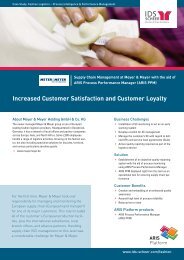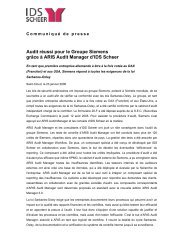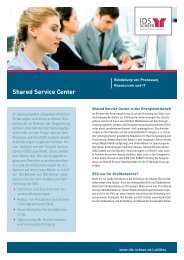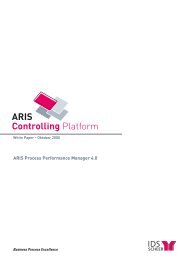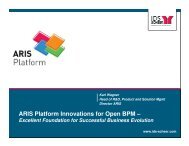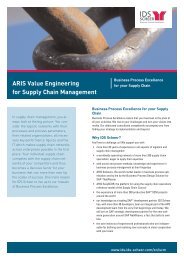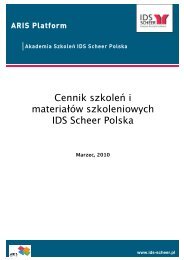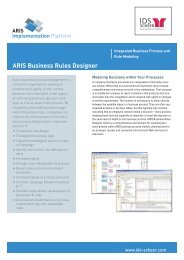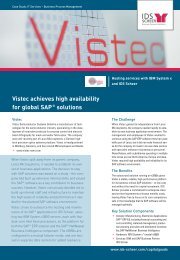Process Intelligence White Paper - IDS Scheer AG
Process Intelligence White Paper - IDS Scheer AG
Process Intelligence White Paper - IDS Scheer AG
You also want an ePaper? Increase the reach of your titles
YUMPU automatically turns print PDFs into web optimized ePapers that Google loves.
ARIS Platform - <strong>White</strong> <strong>Paper</strong><br />
<strong>White</strong> <strong>Paper</strong><br />
January 2009<br />
What is <strong>Process</strong> <strong>Intelligence</strong>?<br />
www.process-intelligence.com
2<br />
<strong>White</strong> <strong>Paper</strong><br />
Table of Content<br />
Business performance of an organization . . . . . . . . . . . . . . . . . . . . . . . . . . . . . . . . . . . . . . . . . . 3<br />
Next generation analytical systems . . . . . . . . . . . . . . . . . . . . . . . . . . . . . . . . . . . . . . . . . . . . . . . . . . . . . . . . . 5<br />
How Do Companies Use <strong>Process</strong> <strong>Intelligence</strong>? . . . . . . . . . . . . . . . . . . . . . . . . . . . . . . . . . . . . . . 5<br />
Strategic KPI management . . . . . . . . . . . . . . . . . . . . . . . . . . . . . . . . . . . . . . . . . . . . . . . . . . . . . . . . . . . . . . . . 6<br />
Tactical <strong>Process</strong> <strong>Intelligence</strong>. . . . . . . . . . . . . . . . . . . . . . . . . . . . . . . . . . . . . . . . . . . . . . . . . . . . . . . . . . . . . . . 7<br />
Aggregating process instances . . . . . . . . . . . . . . . . . . . . . . . . . . . . . . . . . . . . . . . . . . . . . . . . . . . . . . . . . . . . . . . . . . . . . . . . . 8<br />
Benchmarking . . . . . . . . . . . . . . . . . . . . . . . . . . . . . . . . . . . . . . . . . . . . . . . . . . . . . . . . . . . . . . . . . . . . . . . . . . . . . . . . . . . . . . . 9<br />
Variance analysis and root cause analysis using advanced analysis. . . . . . . . . . . . . . . . . . . . . . . . . . . . . . . . . . . . . . . . . . . 9<br />
Organizational analysis . . . . . . . . . . . . . . . . . . . . . . . . . . . . . . . . . . . . . . . . . . . . . . . . . . . . . . . . . . . . . . . . . . . . . . . . . . . . . . . 10<br />
Operational <strong>Process</strong> Monitoring . . . . . . . . . . . . . . . . . . . . . . . . . . . . . . . . . . . . . . . . . . . . . . . . . . . . . . . . . . . 11<br />
Real-time process monitoring . . . . . . . . . . . . . . . . . . . . . . . . . . . . . . . . . . . . . . . . . . . . . . . . . . . . . . . . . . . . . . . . . . . . . . . . . 11<br />
Link to multiple data sources. . . . . . . . . . . . . . . . . . . . . . . . . . . . . . . . . . . . . . . . . . . . . . . . . . . . . . . . . . . . . . . . . . . . . . . . . . 11<br />
Integrated correlation engine to identify critical situations . . . . . . . . . . . . . . . . . . . . . . . . . . . . . . . . . . . . . . . . . . . . . . . . . 11<br />
Interactive dashboards with alert function. . . . . . . . . . . . . . . . . . . . . . . . . . . . . . . . . . . . . . . . . . . . . . . . . . . . . . . . . . . . . . . 12<br />
Seamless integration into ARIS Platform . . . . . . . . . . . . . . . . . . . . . . . . . . . . . . . . . . . . . . . . . . . . . . . . . . . . . . . . . . . . . . . . 12<br />
Implementing <strong>Process</strong> <strong>Intelligence</strong> Solutions. . . . . . . . . . . . . . . . . . . . . . . . . . . . . . . . . . . . . . 13<br />
Strategy phase. . . . . . . . . . . . . . . . . . . . . . . . . . . . . . . . . . . . . . . . . . . . . . . . . . . . . . . . . . . . . . . . . . . . . . . . . . 14<br />
Design phase . . . . . . . . . . . . . . . . . . . . . . . . . . . . . . . . . . . . . . . . . . . . . . . . . . . . . . . . . . . . . . . . . . . . . . . . . . . 14<br />
Implementation phase . . . . . . . . . . . . . . . . . . . . . . . . . . . . . . . . . . . . . . . . . . . . . . . . . . . . . . . . . . . . . . . . . . . 14<br />
Controlling phase . . . . . . . . . . . . . . . . . . . . . . . . . . . . . . . . . . . . . . . . . . . . . . . . . . . . . . . . . . . . . . . . . . . . . . . 14<br />
Usage Scenarios. . . . . . . . . . . . . . . . . . . . . . . . . . . . . . . . . . . . . . . . . . . . . . . . . . . . . . . . . . . . . . . 15<br />
Order processing (order-to-cash). . . . . . . . . . . . . . . . . . . . . . . . . . . . . . . . . . . . . . . . . . . . . . . . . . . . . . . . . . 15<br />
IT service management / incident management . . . . . . . . . . . . . . . . . . . . . . . . . . . . . . . . . . . . . . . . . . . . . 16<br />
Real-time process monitoring in transaction banking . . . . . . . . . . . . . . . . . . . . . . . . . . . . . . . . . . . . . . . . . 16<br />
Sales management (lead-to-order) . . . . . . . . . . . . . . . . . . . . . . . . . . . . . . . . . . . . . . . . . . . . . . . . . . . . . . . . 17<br />
<strong>Process</strong> <strong>Intelligence</strong> in the insurance sector . . . . . . . . . . . . . . . . . . . . . . . . . . . . . . . . . . . . . . . . . . . . . . . . 18<br />
Order processing in logistics . . . . . . . . . . . . . . . . . . . . . . . . . . . . . . . . . . . . . . . . . . . . . . . . . . . . . . . . . . . . . . 19
Business performance of an organization<br />
What is <strong>Process</strong> <strong>Intelligence</strong><br />
Business performance is typically associated with the figures used to measure financial success, such as revenues,<br />
profits, cash flow, etc. Normally; however, it is not possible to influence these financial indicators<br />
directly; rather, they are the result of business processes that represent the organization’s operational activities<br />
(see fig. 1). To improve their performance, organizations must therefore focus on business process efficiency<br />
(“doing things right”) and effectiveness (“doing the right things”). Analyzing the resources used makes<br />
cost reductions possible, while an enhanced customer focus can increase customer satisfaction and hence<br />
revenues.<br />
Information obtained from analyzing and evaluating live business processes provides an important leading<br />
indicator for a company’s performance and value creation activities. Merely collecting KPIs on a data-driven<br />
basis without linking them to processes does not boost business performance, however. <strong>Process</strong>-oriented performance<br />
management tools are required that seamlessly enable day-to-day business management at the<br />
strategic, tactical, and operational level.<br />
What, how, why, and who? These are typical questions relating to the individual aspects of end-to-end business<br />
process performance management when identifying the root cause of a looming divergence from contractually<br />
agreed deadline commitments. After all, no business can afford to constantly violate service level<br />
agreements (SLAs). Alongside the quality of their actual product and service offerings, companies are finding<br />
that the ability to meet customer requirements with regard to response times, flexibility, and service excellence<br />
at an acceptable cost is becoming increasingly important for their financial success.<br />
Figure 1: Leading operational indicators translate into financial performance<br />
3
<strong>White</strong> <strong>Paper</strong><br />
Business <strong>Process</strong> Management and Business Performance Management are closely related, the ultimate aim<br />
of both methods being to gear the business processes of every department and the work of every employee<br />
toward improving performance. Figure 2 shows a typical link between financial indicators and metrics used to<br />
evaluate the performance of business operations (e.g., customer satisfaction, response times, etc.).<br />
By analyzing operational KPIs and including real-world business processes, <strong>Process</strong> <strong>Intelligence</strong> brings a new<br />
dimension to corporate management. <strong>Process</strong> efficiency, and thus operational performance, is transparent at<br />
all times. If defined KPIs are not achieved, the source of the anomaly can be immediately identified and<br />
resolved, which means that management no longer has to wait until the end of the quarter to see if targets have<br />
been met. PI constantly checks how the company is performing in terms of its specified objectives. Crisis management<br />
is replaced by the ability to correct errors before problems become serious.<br />
4<br />
Figure 2: Connecting financial indicators and operational performance<br />
This approach makes it possible to measure company performance, in accordance with the maxim: “You can’t<br />
manage what you don’t measure.” To do this, process-relevant data is extracted from the operational IT systems<br />
and processed.
Next generation analytical systems<br />
What is <strong>Process</strong> <strong>Intelligence</strong><br />
Business <strong>Intelligence</strong> was introduced in many enterprises to automate reporting. Today, however, analytical<br />
systems for evaluating business performance need to meet radically different requirements.<br />
Kurt Schlegel (Gartner): “The view of BI as an IT-centric activity – getting the right information<br />
to the right people at the right time – is outdated. BI has to evolve beyond that and move toward<br />
business processes and business strategy.”<br />
The following aspects will shape the next generation of analytical systems:<br />
� <strong>Process</strong> focus<br />
Business <strong>Process</strong> Management and Business <strong>Intelligence</strong> are currently converging. This means that<br />
analytical components are now being integrated into process execution to control it as efficiently as possible<br />
– partly without human intervention – and support decision-making (Business <strong>Intelligence</strong> in<br />
processes). In addition, analysis techniques, such as OLAP, are being used to measure and analyze<br />
process efficiency. Combining BPM with BI enables the extracted data to be placed in a business context,<br />
thereby allowing management to make informed decisions (Business <strong>Intelligence</strong> about processes).<br />
This fusion of BPM and BI is referred to as <strong>Process</strong> <strong>Intelligence</strong>.<br />
� Use by operational departments<br />
Analytical systems are moving out of their ivory IT towers, with new application concepts allowing<br />
departmental employees to configure systems extremely efficiently to meet their particular information<br />
requirements. Such concepts include mashup technologies, which enable users to combine different<br />
internal and external sources of information (e.g., geographical information, customer addresses, sales<br />
figures, etc.) without the need for programming.<br />
� Increased emphasis on everyday operational activity and the vision of a real-time enterprise<br />
Operational BI, event processing, and Business Activity Monitoring (BAM) all feature technologies that<br />
break with the tradition of analyzing historical data. Instead, the focus is on monitoring live processes<br />
with a view to taking appropriate action before problems actually materialize. This trend is supported by<br />
technological advances, such as replacing conventional database systems with efficient in-memory<br />
technologies.<br />
How Do Companies Use <strong>Process</strong> <strong>Intelligence</strong>?<br />
Business performance analysis involves the application of strategic, tactical, and operational methods according<br />
to different criteria: target group, aggregation of results, and the time factor.<br />
Figure 3: <strong>Process</strong> <strong>Intelligence</strong> can be strategic, tactical, or operational<br />
5
<strong>White</strong> <strong>Paper</strong><br />
Strategic KPI management<br />
Senior managers want aggregated information that is easy to interpret and delivers the relevant facts to support<br />
business management and decision-making activities. A view of the company’s core processes with interactive<br />
traffic lights, trend charts, and deviations from planned KPIs (time, cost, quality, quantity, risk) – that’s<br />
what management needs to keep tabs on performance.<br />
The main purpose of a management dashboard is to provide this information as quickly and concisely as possible<br />
and present it in a clear and attractive way. ARIS Performance Dashboard does this by combining all the<br />
relevant information from core processes to give users an intuitive and interactive view of current company<br />
performance in terms of its processes and organization. Although personalized configuration is possible, the<br />
highest structure displayed by a performance dashboard mostly combines process maps comprising management<br />
processes and main/support processes with analysis of associated KPIs, enabling deviations from<br />
planned values to be identified immediately. Depending on business requirements, process-oriented navigation<br />
in this management view supports drilldown to the desired level of KPI detail (see figure 4).<br />
Figure 4: Aggregated visualization of KPIs<br />
Filters, such as time, region, product group, etc., can be easily applied to analyze specific aspects of business<br />
performance and provide managers with fast access to current, decision-relevant data. Managers only see the<br />
information that is relevant to them and can use the visualized indicators and deviations from planned values<br />
(traffic lights, trend charts) to identify any significant optimization potential. Interactive controls, such as time<br />
bars and context-sensitive smart menus, also enable non-expert users to quickly navigate through the company’s<br />
core process performance. Intuitive data analysis is supported by the combined maps and geographical<br />
information.<br />
The integrated dashboard builder enables (power) users to interactively change and adapt the dashboard<br />
structure via the interface. After selecting the appropriate processes, analysis options, and KPIs, it takes just<br />
a few minutes to choose the type of visualization and how the elements are arranged.<br />
As a Rich Internet Application, ARIS Performance Dashboard combines the outstanding usability of an intelligent<br />
desktop application with the extensive scope of a web solution. The use of Adobe ® Flex technology<br />
avoids the need to install additional components, such as Java plugins, in the browser to develop, operate, or<br />
upgrade ARIS Performance Dashboard. If a company already deploys portal solutions, parts of the dashboard<br />
(process KPIs and analysis options) can be incorporated into an existing portal to provide an integrated view<br />
of the relevant information.<br />
ARIS Platform includes a range of components that provide the process and KPI data to be visualized – ARIS<br />
<strong>Process</strong> Performance Manager (ARIS PPM) and ARIS Business Optimizer in particular deliver dynamic information<br />
that is ideally suited for display on the Performance Dashboard.<br />
6
Tactical <strong>Process</strong> <strong>Intelligence</strong><br />
What is <strong>Process</strong> <strong>Intelligence</strong><br />
While managers typically require an aggregated overview, process owners need more detailed information.<br />
Their job is to ensure process efficiency and quality – which can only be achieved by continuously monitoring<br />
actual processes and evaluating them in terms of quantity, time, cost, quality, and risk. As a rule, KPI analysis<br />
alone cannot identify weaknesses and optimization potential: It is also necessary to display and analyze the<br />
structure of the as-is process to find out which activities were performed and in what order, who was involved,<br />
and where any weaknesses lie. A comprehensive overview of how business workflows are performing is provided<br />
from two perspectives:<br />
� Quantitative, based on objective parameters<br />
� Qualitative, based on graphical visualization of the structure of actual events.<br />
ARIS <strong>Process</strong> Performance Manager (ARIS PPM) is a patented tool that enables enterprises to analyze, evaluate,<br />
and monitor their business processes. It measures the performance of IT-supported corporate processes<br />
and analyzes underlying process flows and organizational structures at the business management level.<br />
Companies thus obtain a comprehensive view of their organization’s performance, with their business workflows<br />
being “surveyed” by way of objective process indicators, seamlessly linked with actual process structures.<br />
Using actual processes, ARIS PPM generates a graphical representation of real-world business workflows.<br />
Because every individual process instance can be processed in different ways, simply linking average KPIs<br />
and modeled process models is not enough. For this reason, ARIS PPM can automatically generate a separate<br />
graphical model for every process instance that displays precise details of this particular process and enables<br />
evaluation and analysis (process discovery).<br />
Business processes are typically supported by an array of disparate application systems (ERP, CRM, workflow,<br />
middleware, legacy systems, etc.). ARIS PPM is capable of combining the process-relevant data from these<br />
systems to reconstruct the execution of each transaction from start to finish (see figure 5).<br />
Figure 5: Reconstructing an actual process<br />
7
<strong>White</strong> <strong>Paper</strong><br />
Aggregating process instances<br />
Where the volume of processes is very high (e.g., over 10,000 transactions/process instances a day), separate<br />
analysis of each transaction is not a viable option – aggregation is called for. ARIS PPM enables these transactions<br />
to be aggregated using any combination of filter criteria (such as all standard orders received last<br />
week from customers in region A with an order value in excess of 8,000 euros) and delivers a graphical representation<br />
of the aggregated processes plus (average) KPIs for the selected set.<br />
Figure 6 shows the potential of visualizing a set of process instances.<br />
8<br />
Figure 6: Visualizing process instances and identifying weaknesses<br />
� Identification (and color coding) of weaknesses (extended processing times, high costs, etc.) and optimization<br />
potential in the process flow<br />
� Analysis of probabilities in the control flow and identification of critical paths, exceptions, etc.<br />
� Analysis of how resources (teams, groups, etc.) are allocated to activities
Benchmarking<br />
What is <strong>Process</strong> <strong>Intelligence</strong><br />
In addition, ARIS PPM is frequently used for (internal) benchmarking purposes to compare various scenarios<br />
(including regions, customer groups, sales organizations, product groups, or any combination of these). Two<br />
types of comparison are used here (see figure 7):<br />
� Comparison of key figures (such as throughput time and process costs in region A vs. region B)<br />
� Comparison with regard to the process structure that ultimately delivers these key figures (comparison<br />
of complexity and structure of processes in region A vs. region B)<br />
This software-based comparison normally enables identification of best practices and specific optimization<br />
measures.<br />
Figure 7: Benchmarking – comparison of KPIs and process structures<br />
Variance analysis and root cause analysis using advanced analysis<br />
Compliance with SLAs is one important area where it is necessary to compare measured parameters with<br />
planned values to identify deviations. <strong>Process</strong> owners can also use automated analysis procedures and intuitive<br />
wizards that enable easier identification of outliers, wide fluctuation ranges, etc. to search for patterns<br />
and transactions with high optimization potential (process mining).<br />
9
<strong>White</strong> <strong>Paper</strong><br />
Organizational analysis<br />
An ARIS PPM add-on module provides an analysis tool that allows a “behind the organizational chart” view<br />
and visualizes actual collaboration between teams and departments within the enterprise (e.g., “How well<br />
does the Technical Sales department fulfill its role in terms of quality and quantity?”). Extensive activity and<br />
communication analysis uncovers the relationships between organizational units and employees, while also<br />
revealing the connection between organizational structure and process execution. Techniques derived from<br />
statistics and sociology (social network analysis) are deployed here, so that users can identify who is performing<br />
a particular task, how often, with whom, and determine the response/throughput times. This enables<br />
optimization that goes beyond pure process changes.<br />
Figure 8 shows the typical procedure when ARIS PPM is used in conjunction with ARIS Performance<br />
Dashboard. If deviations from planned values and weaknesses are identified via the dashboard, ARIS PPM is<br />
used to carry out in-depth analysis into the cause of the anomalies:<br />
10<br />
Figure 8: Top-down analysis<br />
� Distribution (over time, etc.)<br />
� Correlation of features and parameters<br />
� Outlier analysis<br />
� <strong>Process</strong> mining<br />
� Statistical analysis (averages, deviations, etc.)<br />
� Top/flop analysis/rankings<br />
� ABC analysis<br />
� Special graphical representations (variation, portfolios, etc.)<br />
� Visualization and analysis of process structure<br />
� Visualization and analysis of communication structure (communication analysis, activity analysis)<br />
� Benchmarking
Operational <strong>Process</strong> Monitoring<br />
What is <strong>Process</strong> <strong>Intelligence</strong><br />
There is an unstoppable trend toward acceleration. Financial transactions, logistics processes, customer relationship<br />
management, compliance with legal requirements – all require lightning-fast response times and point<br />
the way inexorably toward a real-time world. A great deal of information is already obsolete and useless after<br />
just one day. To gain a competitive edge, many enterprises are deploying business models that are approaching<br />
real-time:<br />
� Loans are approved or rejected online in minutes<br />
� Flight and hotel reservation systems display up-to-the-minute details of available options<br />
� Customers making purchases from an online store are also offered other products<br />
Conventional business intelligence technologies cannot cope when it comes to operational monitoring of business<br />
processes, because neither data extraction nor results analysis and presentation is event-driven, which<br />
makes it difficult to monitor end-to-end processes. Event processing is a new technology that links rapid analysis<br />
directly to operational processes. ARIS <strong>Process</strong> Event Monitor (ARIS PEM) enables organizations to analyze<br />
current transactions and respond to critical events in real time. Its high-performance tracking function<br />
continuously monitors incoming events and proactively identifies critical situations, freeing the user to concentrate<br />
on the most important exceptions and take immediate action. This enables a timely response to risk<br />
or errors in the live business process: prevention is better than cure.<br />
Real-time process monitoring<br />
ARIS <strong>Process</strong> Event Monitor delivers ad-hoc information about the current status of business processes, such<br />
as<br />
� Transaction exceeds the specified response/throughput time<br />
� Transaction violates SLAs<br />
� Transaction breaches rules (e.g., dual control, approval procedure, etc.)<br />
� Team is currently overloaded due to high volume of work<br />
Acting as a monitoring system for business processes, ARIS PEM reports this data to the employees and managers<br />
responsible.<br />
Link to multiple data sources<br />
To extract process relevant events from operational IT applications, numerous extractors are available that<br />
allow efficient access to a wide range of systems (operating systems, database systems, applications).<br />
Integrated correlation engine to identify critical situations<br />
The integrated correlation engine is able to identify critical situations from the constant flow of events, such<br />
as SLA violations and rule infringements. Through the correlation of input data (including data from different<br />
sources), new events can be generated and users informed promptly of any problems via a dashboard, e-mail,<br />
or SMS, or automatic responses can be triggered. ARIS <strong>Process</strong> Event Monitor does this using Systar technology,<br />
which was rated best provider by a leading IT analyst in the most recent market survey of Business<br />
Activity Monitoring.<br />
11
<strong>White</strong> <strong>Paper</strong><br />
Interactive dashboards with alert function<br />
Highly intuitive dashboards provide a large number of users with KPIs and timely information on the current<br />
status and alert them in the event of escalation. Dashboard content is configured to customer requirements.<br />
The following views ship as standard:<br />
� <strong>Process</strong>es (status of transactions and activities)<br />
� Organization (status of participating teams)<br />
� Exceptions (current problems and rule infringements)<br />
� Track & trace (interactive search for individual transactions)<br />
12<br />
Figure 9: Example of an interactive real-time dashboard<br />
Seamless integration into ARIS Platform<br />
ARIS PEM is seamlessly integrated into ARIS Platform, enabling users to graphically model processes, KPIs,<br />
and dashboards in ARIS Business Architect and transfer them to ARIS PEM with a single mouse click. ARIS<br />
<strong>Process</strong> Performance Manager (ARIS PPM) also serves as a “memory” and is used for detailed analysis of<br />
process data/structures and identification of optimization potential.
Implementing <strong>Process</strong> <strong>Intelligence</strong> Solutions<br />
What is <strong>Process</strong> <strong>Intelligence</strong><br />
In order to quickly and efficiently adapt their process structures to changes, businesses need to become more<br />
flexible by aligning their organization with business processes, thus establishing a system of continuous<br />
process optimization. This process-oriented approach integrates all levels of business management, from<br />
long-term strategic objectives, tactical tracking, and structural analysis of business processes to operational,<br />
everyday real-time processes. ARIS products enable combined analysis of quantitative and qualitative results<br />
plus continuous improvement of target processes within the enterprise based on as-is processes.<br />
ARIS Value Engineering (AVE) is a procedure model that was developed to introduce and leverage these solutions<br />
(see figure 10). This model offers a consistent workflow plan for implementing an automated solution that<br />
measures, analyzes, and optimizes business processes. The work packages that make up the roadmap enable<br />
the introduction of a scalable solution. In the strategy phase, operational KPIs are derived from the strategic<br />
objectives and assigned to the various states of the end-to-end processes. Detail is added to the process-oriented<br />
BI solution in the design phase before it is implemented and integrated into the existing IT environment.<br />
The solution is then rolled out in the controlling phase to enable effective process improvements based on the<br />
measurement results.<br />
Figure 10: ARIS Value Engineering for implementing <strong>Process</strong> <strong>Intelligence</strong> solutions<br />
13
<strong>White</strong> <strong>Paper</strong><br />
Strategy phase<br />
This phase begins with defining strategic objectives, deriving measurable KPIs, and selecting end-to-end<br />
processes. These requirements are linked and stored in the central ARIS repository, enabling process-oriented<br />
requirements analysis to ensure that process knowledge can be reused within the organization.<br />
� Direct assignment of corporate objectives to measurable KPIs<br />
� Level of process orientation within the enterprise is taken into account<br />
� Scalable solution via flexible adaptation of work packages<br />
� Consistent requirements in the central ARIS repository<br />
� Results can be reused for subsequent BPM projects<br />
Design phase<br />
The focus of this phase is on preparing to implement the solution. The process flow to be measured is divided<br />
into sections, which correspond to specific states of the runtime data of the associated IT systems. The customer-required<br />
analyses, report templates, and dashboards are also defined here.<br />
� States in the process flow can be measured using IT runtime data<br />
� Detailed planning of process-oriented BI solution<br />
� Preparation for technical implementation<br />
Implementation phase<br />
The output of this phase is a validated, integrated solution that will be developed in iterative steps into a comprehensive<br />
measurement and analysis tool. Role-based user training is then provided prior to rolling out the<br />
solution. When the solution is operational, data is automatically collected by continuous logging and measuring<br />
of actual processes. This results in a complete knowledge base that delivers up-to-the-minute data on the<br />
current efficiency and quality of business processes.<br />
� Technical implementation<br />
� Iteration cycle between test and validation<br />
� Integration of solution into the IT environment<br />
� Role-based user training<br />
� Solution roll-out<br />
Controlling phase<br />
Users evaluate their degree of goal achievement by way of intuitive dashboards and automatic reports, making<br />
it possible to quickly identify weaknesses in the recorded process flows and implement improvements.<br />
<strong>Process</strong> <strong>Intelligence</strong> facilitates understanding of the actual workflows step-by-step in graphical process models,<br />
which in turn makes it easier to identify best practices.<br />
� Automatic measurement of process efficiency via KPIs<br />
� Structures of real-world processes rendered transparent<br />
� Identification of weaknesses in the process flow<br />
� Benchmarking of best and worst practices<br />
� Planning of improvements<br />
14
Usage Scenarios<br />
Order processing (order-to-cash)<br />
What is <strong>Process</strong> <strong>Intelligence</strong><br />
Optimizing order processing involves business processes with multiple interfaces to partners, customers, and<br />
logistics service providers. Due to the high number of interfaces, these processes are particularly error-prone:<br />
Experts estimate that at least 10 percent of all such processes are inefficient, with examples including timeconsuming<br />
credit checks that delay or prevent completion of the transaction. Although cost reduction is a<br />
strategic goal for many organizations, the work involved in resolving process problems actually increases<br />
costs. Managers are thus faced with the dilemma of reducing costs while at the same time deploying additional<br />
staff to ensure smooth execution of sales and logistics processes.<br />
<strong>Process</strong> <strong>Intelligence</strong> reveals opportunities for savings by creating a transparent view of the entire process<br />
flow, including the interfaces (such as EDIFACT). Automatic alerts when errors occur in the process flow save<br />
employees the time-consuming effort of trying to pin down problems. Weaknesses in individual process areas,<br />
such as sales, procurement, inventory, transport, invoicing, and returns/complaints, are highlighted and<br />
improvement potential identified. KPIs for sales, quality, time, profit margin, service levels, and the associated<br />
causes of errors ensure that a high level of process quality is maintained at all times.<br />
Figure 11: ARIS Performance Dashboard<br />
15
<strong>White</strong> <strong>Paper</strong><br />
IT service management / incident management<br />
IT service management focuses on process quality, as measured by service level agreements (SLAs). Although<br />
SLAs tend to be highly customer-specific, they are also very time-critical, particularly where incident management<br />
is concerned. If a live system fails, a response is often required within minutes.<br />
To avoid penalties, businesses in this sector have to constantly monitor critical queries and manage problem<br />
scenarios, such as an unexpectedly high volume of such calls. Timely, automatic analysis and execution of<br />
ticket-handling processes is therefore essential. Figure 12 shows an example of a real-time dashboard that<br />
brings together key information:<br />
� “Current tasks” warns of risks in current live processes, which require an immediate response.<br />
� “Current status” provides an overview of process execution and highlights unexpected behavior (such<br />
as an unexpectedly high volume of queries).<br />
The lower half of the dashboard provides various types of analysis to identify systematic weaknesses in the<br />
process and leverage optimization potential.<br />
Figure 12: Example of a real-time dashboard for incident management<br />
Real-time process monitoring in transaction banking<br />
Transaction banks execute large numbers of extremely fast processes. <strong>Process</strong>ing delays represent a significant<br />
financial risk and can damage their corporate image. Moreover, transactions are subject to stringent regulatory<br />
requirements. Manual tracking of enterprise-wide processes is difficult to implement at the transaction<br />
level, but short response times are vital in order to resolve bottlenecks and problems with minimum delay.<br />
At the business process level, real-time, event-driven process monitoring offers a reliable way of automatically<br />
monitoring the status of all current transactions. ARIS PEM performs this task by way of fully automated,<br />
rule-based correlation filters that respond to specific patterns in the event streams of the IT systems with an<br />
immediate warning. These exceptions are reported immediately to the process manager, who can quickly take<br />
the necessary corrective action before a bottleneck causes problems.<br />
This automated process monitoring minimizes the risk of payment system failures and increases process efficiency,<br />
because every transaction that deviates from the norm is identified. ARIS PEM is thus a permanent,<br />
real-time early warning system that ensures that all live business processes are transparent and of a consistently<br />
high quality.<br />
16
Sales management (lead-to-order)<br />
What is <strong>Process</strong> <strong>Intelligence</strong><br />
The sales manager’s main task is to efficiently manage the process from lead generation through to closing the<br />
deal. In this context, the ARIS controlling/monitoring solutions are used to support an organization’s paradigm<br />
change toward process-oriented selling. The main lever available to a sales manager seeking to achieve continuous<br />
process improvement is automatic transparency of the current status. No additional effort is required<br />
by sales staff because the necessary data can normally be extracted directly from the company’s CRM system.<br />
Along with KPI calculation for the whole process or for subprocesses, process-oriented analysis of quotation<br />
processing offers an early warning system for problems and supports internal auditing/customer auditing functionality.<br />
Integration between the operational and strategic levels is particularly effective, i.e., linking the lead management,<br />
opportunity management, contract conclusion, invoicing, and commission subprocesses to enable simple<br />
drilldown of aggregated views to the individual quotation process. Typical KPIs that can be analyzed here<br />
according to user-defined dimensions (e.g., industry, region, time, and sales type) include pipeline value, forecast<br />
value, incoming order value, lead-to-opportunity time, opportunity-to-order time, conversion rate, and<br />
forecast accuracy (see figure 13).<br />
Figure 13: Example of a sales dashboard (lead-to-order)<br />
17
<strong>White</strong> <strong>Paper</strong><br />
<strong>Process</strong> <strong>Intelligence</strong> in the insurance sector<br />
By continuously measuring and analyzing the efficiency of their core processes, such as application management<br />
and claims handling, insurers can achieve huge competitive advantages. Instead of analyzing business<br />
processes selectively or at the theoretical level, ARIS PPM automatically evaluates real transactions in the<br />
underlying IT systems – from insurance application to signed contract, across the entire organization. This creates<br />
transparency along the value chain and often uncovers hidden potential for efficiency savings.<br />
Successful insurers automatically measure and evaluate their actual business processes using operational<br />
KPIs, such as throughput times from new application to issuing the policy or the process costs of transactions<br />
involving manual intervention.<br />
<strong>Process</strong> <strong>Intelligence</strong> also reveals the underlying processes executed for every KPI, giving process managers<br />
an insight into the conditions that give rise to repeated problems at specific stages of processing.<br />
ARIS PPM provides the necessary flexibility for users to understand the transactions and individual steps of<br />
the automatically generated process structures via graphical process models. It also supports aggregation of<br />
mass processes into a single sample process. A complete picture of the entire process is retained from beginning<br />
to end and the causes of any material process problems are identified in the context of all participants.<br />
The measurement and analysis results at the process level are also available for internal benchmarking purposes,<br />
such as comparing how individual teams reap the efficiency benefits of process flow modifications.<br />
ARIS PPM delivers hard facts that force line managers to demonstrate their contribution to business success.<br />
At the same time, everyone involved in the process can access a constantly up-to-date knowledge base in<br />
order to eliminate recurring process weaknesses within their department before they impact negatively on the<br />
company’s bottom line.<br />
Successful insurers deploy <strong>Process</strong> <strong>Intelligence</strong> to slash wait times for new customers, boost the quota of<br />
instant decisions, and improve the level of automation thanks to fewer customer queries, thereby freeing up<br />
resources.<br />
18<br />
Figure 14: ARIS Performance Dashboard
Order processing in logistics<br />
What is <strong>Process</strong> <strong>Intelligence</strong><br />
Faced with ever-changing market conditions and business relationships, organizations are under constant<br />
pressure to upgrade their logistics processes. Logistics innovations are being driven in particular by international<br />
competition in the transport sector. As logistics requirements become increasingly complex and global,<br />
it is vital that organizations remain flexible – which means ensuring transparent goods movements and efficient<br />
utilization of transport capacity. There are also specific customer requirements to fulfill, such as providing<br />
presentation services.<br />
Handling orders that span multiple transport areas is a core process in this sector.<br />
ARIS <strong>Process</strong> <strong>Intelligence</strong> & Performance Management enables integrated, cross-system process analysis<br />
throughout the logistics chain, from order entry to goods movements and invoicing.<br />
By integrating and optimizing important quality-related supply chain KPIs (e.g., number of order changes, pickup<br />
compliance, etc.), cost (e.g., cost per order, cost per shipment), and time (e.g., time required for order entry,<br />
elapsed time between loading and departure of truck, etc.), companies can achieve long-term flexibility and a<br />
competitive edge.<br />
Introducing transparent process analysis in the context of order processing also yields a host of other benefits:<br />
� Managing the supply chain for major customers using defined KPIs and SLAs<br />
� SLA monitoring and benchmarking against transport companies/customers<br />
� Proactive, timely control via introduction of an early warning system to monitor KPIs<br />
� Improvement of customer service and quality through special automated reports on elapsed times, quantities,<br />
SLA compliance, etc.<br />
� Identification of optimization potential within the transport chain<br />
19
© Copyright (C) <strong>IDS</strong> <strong>Scheer</strong> <strong>AG</strong>, 2001 – 2008. All rights reserved. The contents of this document is subject to copyright law. Changes, abridgments, extensions and supplements<br />
require the prior written consent from <strong>IDS</strong> <strong>Scheer</strong> <strong>AG</strong>, Saarbrücken, Germany. Reproduction is only permitted provided that this copyright notice is retained<br />
on the reproduced document. Each publication or translation requires the prior written consent from <strong>IDS</strong> <strong>Scheer</strong> <strong>AG</strong>, Saarbrücken, Germany. “ARIS”, “<strong>IDS</strong>”,<br />
“<strong>Process</strong>World”, “PPM”, ARIS with Platform symbol and Y symbol are trademarks or registered trademarks of <strong>IDS</strong> <strong>Scheer</strong> <strong>AG</strong> in Germany and in many countries all<br />
over the world. “SAP NetWeaver” is a trademark of SAP <strong>AG</strong>, Walldorf. All other trademarks are the property of their respective owners. U.S. pat. D561,778, pat.<br />
D561,777, pat. D547,322, pat. D547,323, pat. D547,324<br />
ID-Number: WP-PI-0109-E<br />
<strong>IDS</strong> <strong>Scheer</strong> <strong>AG</strong><br />
Headquarters<br />
Altenkesseler Str. 17<br />
66115 Saarbruecken<br />
Phone: 49 681 210-0<br />
Fax: 49 681 210-1000<br />
E-mail: info@ids-scheer.com<br />
www.ids-scheer.com



